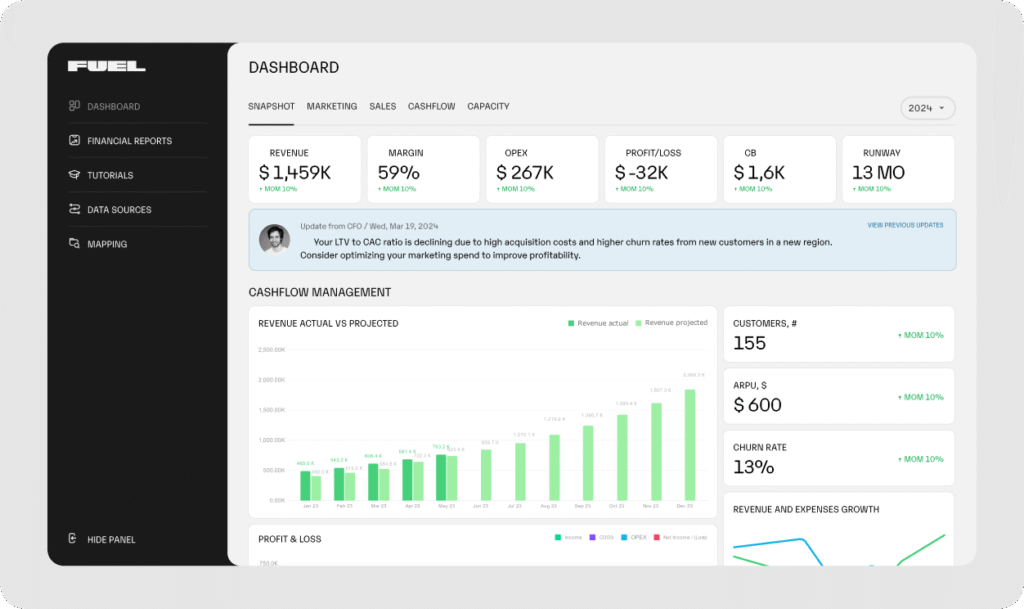

.png)
Sarah, a finance director at a $50M SaaS company, just got off a call with an Anaplan sales rep. The quote? $50,000 annually, plus implementation and consultant fees that easily double the total cost. That's for a tool that would take five months to set up.
“There has to be a better way,” she thought, staring at the proposal that would eat up a quarter of her entire department's budget.
Sound familiar? Finance teams everywhere are re-evaluating enterprise tools like the Anaplan platform, discovering that bigger doesn't always mean better — especially when you're paying massive prices for features you'll never use.
The business intelligence and workforce planning tool, Anaplan, built a reputation as the go-to solution for large enterprises, but growing frustration around pricing transparency, implementation complexity, and steep learning curves has many finance leaders looking elsewhere.
This guide breaks down everything you need to know about Anaplan pricing, features, real user experiences and introduces a smarter alternative that delivers professional-grade financial planning and predictive analytics without the enterprise headache. One that's up and running in weeks, not months.
Here's the first red flag: Anaplan doesn't have any sort of pricing on its website. No transparent cost structure, no clear tiers, no way to budget without sitting through a sales demo. While that's more or less standard in the industry, this site requires you to input a lot of personal data before giving you any sort of trial, demo or tier structure.
What we do know comes from third-party sources and user experiences shared across review sites and forums.
Based on verified user reports:
According to PeerSpot reviews, the entry-level is anywhere from about $30,000 to $50,000 a year; however, it does go up significantly after that, depending on the complexity and how much space you're using.
SelectHub research indicates that Anaplan pricing starts at $20,000 annually. But that's just the starting point.
Reality check from TrustRadius users:
“Reviewers consistently highlight that Anaplan's pricing is on the higher end, which can lead to a longer return on investment of the business processes it helps improve. This aspect raises concerns, especially for smaller organizations that may struggle to justify the expense given their scale and requirements.”
Hidden costs you won't see upfront:
Apparently, administrator licenses cost much more than licenses for standard customers of the Anaplan platform. Still, many say that the value it brings still makes it better than competitors like SAP or IBM planning analytics, despite the higher costs. Licensing includes storage allocations, but there are additional fees for bigger capacity or specific services, e.g., model optimization.
Plus, implementation takes a good few weeks and can cost up to $50k–$250k.

Anaplan is an enterprise-grade connected planning platform that promises to improve business performance with accurate financial planning, forecasting and performance management, all part of the cloud-based solution.
Anaplan is a comprehensive business planning and analysis platform that can replace spreadsheet-centric processes with a more feature-rich, collaborative environment and user-friendly interface. The platform attempts to bridge the gap between familiar spreadsheet interfaces and modern financial planning software tools through three main views:
The platform centralizes all the data from major business functions, including finance, accounting, HR, sales, marketing and supply chain. This unified data hub approach enables more accurate financial forecasting and scenario planning by eliminating information silos.
Ideal for: Large enterprises (500+ employees) with complex business strategies, multiple business units and dedicated implementation teams.
The platform handles large-scale, complex planning scenarios that would overwhelm traditional spreadsheets (and their users). However, this comes with significant complexity that requires training and technical expertise.
Real user feedback reveals a consistent pattern: Anaplan is helpful for large enterprises but creates significant challenges around cost, complexity and implementation timelines, with somewhat limited integrations.
“Its flexibility allows us to customise the tool for each unique aspect of the business. While it is extremely flexible, it is important to have the right people in place to help manage the tool long term,” notes a verified G2 reviewer.
Users consistently praise Anaplan's computational power and ability to handle complex multi-dimensional modeling that would be impossible in Excel.
TrustRadius research found that “For larger enterprises, many users find that the cost is justified due to the platform's advanced capabilities in handling complex data modeling and integrated planning. However, this creates mixed opinions as smaller organizations may not experience the same level of ROI, leading to concerns about the platform's affordability for their needs.”
Reddit discussions and community forums consistently highlight these friction points, with many users questioning whether the complexity is worth the capabilities for their specific use cases.
Looking for a simpler approach to financial planning and analysis? Well, you're in for a treat!
While Anaplan focuses on enterprise complexity, Fuelfinance takes a different approach: combining expert financial guidance (as in, from a real human) with intelligent automation and powerful AI capabilities to deliver professional-grade FP&A capabilities without the headache of lengthy learning.

Instead of forcing your team to learn a completely new system, Fuelfinance provides a comprehensive financial management solution that includes both technology and human expertise. You get AI-powered forecasting, automated reporting and a dedicated finance professional who understands your business and specific needs — all for a fraction of Anaplan's cost.
Unlike Anaplan's hidden pricing model, Fuelfinance is made to scale with you. Our Bootstrap plan for pre-seed stage startups is completely free (or just $39/month if you want to automate data transfer from QuickBooks). As you grow, we'll adjust the pricing and capabilities to fit you perfectly, so you have everything you need and never need to pay for what you don't. As a rule of thumb, we offer these tiers:
Each tier includes not only easy-to-use software that integrates with 350+ data sources, but also a dedicated finance expert who knows your business and our program, eliminating the need for expensive external consultants. Fuelfinance lets you save 50-90% compared to the cost of hiring an in-house CFO or finance team.
Schedule a quick demo to see how we can help!
✅ AI-powered functionality with human support — Get the best of both worlds: intelligent automation plus a finance manager who understands your industry; we do AI for finance, including forecasting, analysis, reports and more
✅ Plug-and-play setup — Easy, two-week implementation with expert guidance instead of months of painful configuration and training
✅ Dedicated finance expert included — Every client gets assigned financial professionals, not just software access
✅ Faster time to value — Start seeing actionable insights immediately rather than waiting through lengthy implementation cycles
✅ Modern integrations — Connect with 350+ tools, including QuickBooks, HubSpot, Salesforce, and a native Excel and Google Sheets integration if you prefer to work in spreadsheets
✅ Real-time financial dashboards — Access comprehensive financial metrics and cash flow forecasting on intuitive interfaces and a dashboard tailored to your needs
Ready to see how modern FP&A should work? Book a demo today to discover why finance teams are making the switch from complex enterprise tools to smarter, more accessible solutions.
Real Fuelfinance users report dramatically different experiences compared to traditional enterprise tools:
Ease, profitability and value: “Fuel got us to profitability and made finance function about 5x better, for 1/3 of a cost. I think it's the combination of their software, which incorporates their experience and is constantly improving, and the managers who can focus your attention on the most crucial pieces and explain the financial jargon, processes, and ideas you might not intuitively understand.
I never get anything close to what I got with Fuel with the expensive financial managers and partial CFOs I hired - all of them were bound to the old ways of thinking, using endless versions of spreadsheets and making finance harder for me to understand as a CEO, not easier,” reports a mid-market founder.
Expert support: “Fuel team's implementation of financial best practices into their product is amazing. It's like having our own financial consulting team at our fingertips. We constantly use their advice and that`s what makes our revenue grow,” notes one customer.
Cost efficiency: A small business marketing specialist shared measurable results: “Unlike other financial or ERP systems that start with $100k/year and may take a year to implement, Fuel's services start with as little as $999/month and only take 1-2 months to be up and running.”
Minor considerations: Some users note that the platform focuses specifically on financial planning rather than broader enterprise planning use cases like supply chain or HR workflows. However, most find this specialization beneficial as it delivers deeper financial capabilities than one-size-fits-all solutions.

ColdIQ, a B2B SaaS company, implemented Fuelfinance and achieved:
Want to see similar results for your company? Get started here.
After analyzing Anaplan pricing, user experiences, features and implementation requirements, we can see several key patterns:
Instead of wrestling with expensive, complex enterprise tools, smart finance leaders choose solutions that combine powerful technology with human expertise. They get better results faster while focusing their time on strategic decisions rather than system administration.
Book your free demo and let us support your business growth.
Anaplan handles complex, enterprise-scale financial planning scenarios that require sophisticated multi-dimensional modeling. It's good for large organizations needing to coordinate planning across departments, handle massive datasets and create intricate scenario models.
The platform works best for companies with dedicated technical teams who can manage the implementation complexity and ongoing system administration requirements.
However, according to Cube Software analysis, “Anaplan is a bulky, heavy solution that's only worth considering for a large, enterprise company. Unless you need Anaplan's powerful calculation engine, it's hard to make a clear recommendation here.”
Anaplan doesn't publish official pricing, but based on verified user reports and industry analysis, annual licensing fees start at $20,000-30,000. Additional costs include implementation, training and custom integrations. The total Anaplan pricing varies depending on the complexity and the help you need.
Based on extensive user feedback and expert analysis, common Anaplan disadvantages include:
Generally no. The platform is specifically designed for large enterprises and creates several barriers for smaller organizations, including cost, complexity mismatch and resource requirements.
Better alternatives for small businesses include solutions like Fuelfinance, which provide professional-grade financial management with expert support at accessible price points. These modern platforms deliver the essential capabilities small businesses need — accurate forecasting, automated reporting and strategic guidance — without enterprise complexity and costs.


Just imagine how that would transform your team’s productivity and focus? Talk to our financial experts to know more.